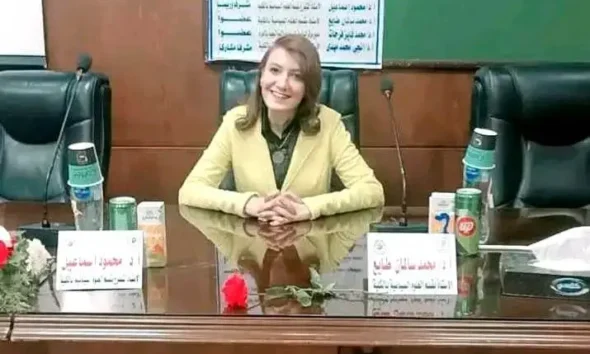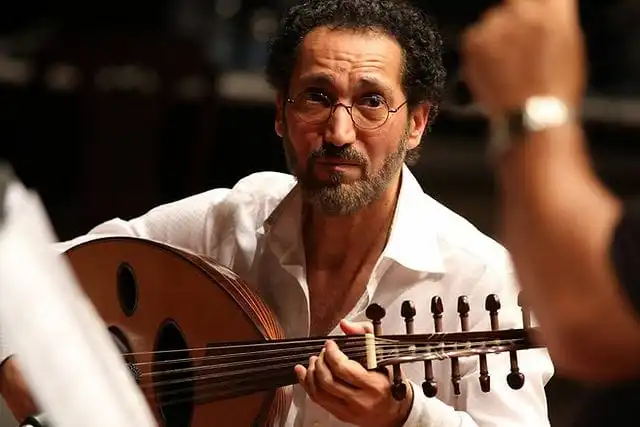Home » Interviews » Naseer Shamma to Arabisk London: Oriental music, Like “Hijaz” and “Bayat,” Maqams Give Youngsters a Sense of Security and Attractiveness!
Interviews
Naseer Shamma to Arabisk London: Oriental music, Like “Hijaz” and “Bayat,” Maqams Give Youngsters a Sense of Security and Attractiveness!
Published
5 months agoon
By
Huda
Born in 1963 in the Iraqi city of Kut, Naseer Shamma started his career in music and melodies, particularly with the oud, after graduating from the Institute of Musical Studies in Baghdad in 1987.
Interviewed by: Mohsen Hassan
He later earned a doctorate in musical philosophy and won numerous prestigious awards in the fields of composition and musical performance.
As a result, Naseer Shamma was awarded the Iraqi Artists Syndicate’s Best Emotional Melody in Iraq award for three consecutive years, from 1988 to 1990.
In addition, he received over 50 honours, the most significant of which were the Best Iraqi Artist Award in 1994, the Royal British Academy Award in 1998, and the Rotterdam Arab Festival Award.
His reputation grew as a result of this musical quirk, and he frequently appeared in the music halls of European cities including Paris, London, and Rome. Additionally, Cairo was the site of the first Arab Oud House.
His zeal for advancing the art of music and its instruments—particularly the oud—was evident through the establishment of the organization’s later centres in Abu Dhabi, Baghdad, and Alexandria.
In addition to his humanitarian efforts in aiding the displaced and victims of crises and wars, the Arab Oud House Orchestra’s concerts and performances have taken place all over the world, showcasing the creative and inventive artistic contribution of this Arab artist with a global artistic tendency.
He is an ambassador of peace and goodwill for numerous local, regional, and international bodies, unions, and institutions. Arabisk London interviewed Dr. Naseer Shamma, a musician who blends contemporary and authenticity.
First, which aspects of Naseer Shamma’s musical approaches are consistent and variable?
When it comes to the constant and variable aspects of my musical techniques, we can say that the constant is that I mainly use oriental instruments—particularly the oud, an Arab musical symbol that embodies the cultural and artistic identity of the East—while maintaining the spirit of oriental music and its authenticity. I thus preserve this authenticity by using oriental scales and rhythms that capture the richness of this region’s music.
Regarding the variable in my techniques, it manifests in my use of innovative approaches to engage the audience and broaden the expressive possibilities of oriental music. Furthermore, I always look for a new musical language that blends tradition with global openness by utilising contemporary methods and blending Eastern scales with Western influences. These changes are an attempt to improve and enhance oriental music so that it may interact with global factors, rather than a sort of abandoning of it.
Do you, Naseer Shamma, think that Western music has supplanted some qualities of oriental music?
Naturally, some influences may have weakened the original purity of oriental music, but this does not imply a total loss of identity. In the case of oriental music, it can be said that this transformation is a common occurrence in the age of globalisation, as it has lost some of its characteristics in favour of the Western style.
However, the influences I mentioned may present an opportunity to re-present oriental music in a contemporary way, appeal to a wider audience, and maintain its essence and oriental spirit.
These days, music is a universal language that offers many opportunities. How can we take the art of music to new heights in the context of this momentum, in your opinion?
Given this worldwide musical trend, we can push the art of music to new heights. We can do this by going back to the origins of our culture, discovering the spiritual and rhythmic richness of our ancestry, and developing new musical venues that blend the authenticity of the past with the innovations of the present. 
Today’s world seeks distinctiveness, and local identity provides a rich environment for a unique voice that, if delivered in a way that is current with the recipient’s goals, may make an impression on the world stage.
Moving away from conventional models and presenting music as a storytelling medium that conveys stories, visuals, and cosmic senses in addition to melodies is another approach.
To do this, music may be combined with other artistic mediums like painting, writing, and performing arts to create cohesive artistic experiences that draw viewers in and include them in the musical experience. Oriental music can be redefined and new avenues for engagement with it can be opened via technology.
For instance, using artificial intelligence to create overlapping sound worlds can enable music to converse with natural or even cosmic sounds, opening up possibilities for producing music that transcends our familiar auditory perceptions and inspires unexpected and novel sound explorations.
How did Saudi Arabians react to your musical presence?
In Saudi Arabia, the crowd response was fantastic, brimming with energy and candour. I discovered that the Saudi audience had a strong love for music, like oriental music, and wanted to learn more about the variety of art and culture that blends tradition and contemporary.
This exchange demonstrates a genuine desire for art and a strong openness to engaging with a wide range of musical experiences, which makes performing music here a motivating and rewarding experience.
What does Naseer Shamma think of this nation’s new artistic reality?
The Kingdom’s new artistic reality is undergoing a significant metamorphosis and a vigorous push to promote the arts and culture in all of its manifestations.
This vibrant creative environment provides an ideal setting for the advancement of traditional arts and the addition of fresh components that give legacy a modern feel.
Cultural infrastructure, such as music halls and theatres, as well as the establishment of organisations and projects that promote the arts and assist artists, are of considerable interest.
This tendency, in my opinion, provides Eastern music with a wider audience and more opportunities to interact with people from other backgrounds, which might help redefine the place of Arabic music in the local and regional context.
In terms of Saudi Arabia, I found your musical piece “Between the Palm Trees,” which Naseer Shamma performed in Dhahran, to be magnificent, and I listened to it several times. However, it appeared that you were musically influenced by Turkish Sufism. Do you agree or disagree?
I appreciate your remarks and your admiration for the work. I composed the song “Between the Palm Trees” in 1994. Between Baghdad and Babylon, there existed a route that resembled a palm jungle.
When I arrived at the Babylon Theater, I improvised the work under the impact of what I observed. There is undoubtedly a Sufi spirit flowing through the music. It may fit nicely with the Turkish Sufi influences, which have a unique personality based on spiritual profundity and elegantly straightforward presentation.
Since it speaks to the depths of the soul in a language where sound transcends place and culture, this Sufi element of music touches listeners wherever they are. That being said, I think the influence in this piece comes from Sufism in general rather than from a particular school.
Whether Turkish or not, I decided to give the piece a transparent character that blends the simplicity of the melody with its serene rhythms, drawing inspiration from the spirituality associated with Sufism as a musical and artistic philosophy.
The scene of palm trees, which carries in its symbolism authenticity and calmness mixed with the spirituality of the land and the depth of heritage, is another source of inspiration. I think the work is an artistic creation that transcends boundaries since it blends this Sufi spirit with the local uniqueness of each location.
Regarding Naseer Shamma’s musical appearances, what about the youngster and childhood?
The kid and childhood have a unique place in my musical performances since, in my opinion, music may have a significant role in shaping a child’s consciousness and creative taste at a young age. For this reason, we constructed Ouds and Qawans for them in the Oud Houses in sizes appropriate for small age groups.
When it comes to youngsters, we have seen genuine interest and accomplishment. For instance, I appointed the youngest graduate—who is only 14 years old—to teach at Cairo’s Oud House.
Children may listen to music with open hearts since they are naturally curious and have pure feelings. I am so eager to offer musical compositions that complement their dreamy, serene, and uncomplicated universes.
What kind of music is appropriate for children in this setting, both today and in the future?
Children’s music must have certain components, such as straightforward rhythms, lovely melodies, and upbeat compositions that simultaneously evoke feelings of joy and serenity. 
Oriental music may be quite appropriate in this situation; melodies based on Maqams like “Hijaz” and “Bayat” might be offered, giving youngsters a sense of security and attractiveness! while also fortifying their ties to their musical heritage.
Children can eventually participate in interactive seminars that teach them about musical instruments and give them a chance to try them out, as well as live performances.
Here, music has the potential to be more than simply a listening experience; it may become a sensory encounter that fosters their creativity and improves their capacity for auditory communication with the outside world.
And lastly, one more word. What are Naseer Shamma’s thoughts?
I express my gratitude to Arabisk London magazine for the interview and the questions posed, and I hope the editorial team continues to be successful and guided.
With God’s grace, our musical arts and their genuine and creative perspectives that preserve our heritage and common identity, as well as our interactions with the entire world and its various cultures and civilisations, will meet the expectations of the magazine’s readers and the Arab audience in general.
This will be achieved through a musical art that embodies the soul and transcends geographical boundaries. Greetings to everyone.

Ahmed Al-Badr the Saudi Businessman

Saudi Designers Ladies’ Role in the Fashion Revival & Vision 2030

Lina Gazzaz: A Saudi Artist Who Painted History in Modern Colours!

Terrorism Specialist Dr. Shimaa Samir: Multipolarity is Undermining Nuclear Deterrence, and it is Possible to Tame Extremist Ideology!

Daniah Orkoubi: A Saudi Entrepreneur and Technological Pioneer








